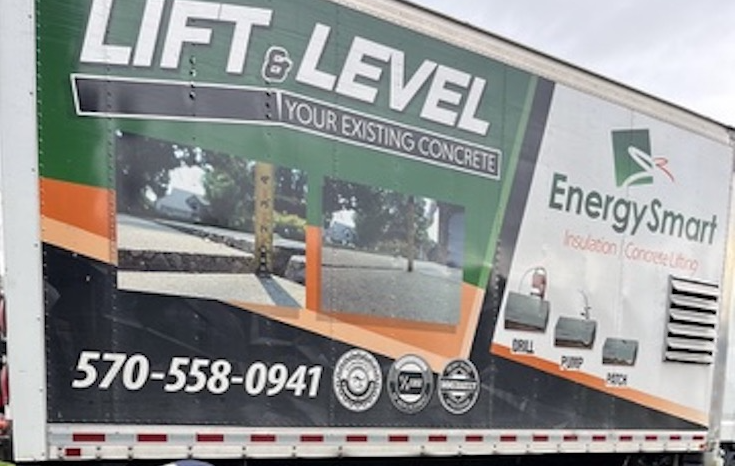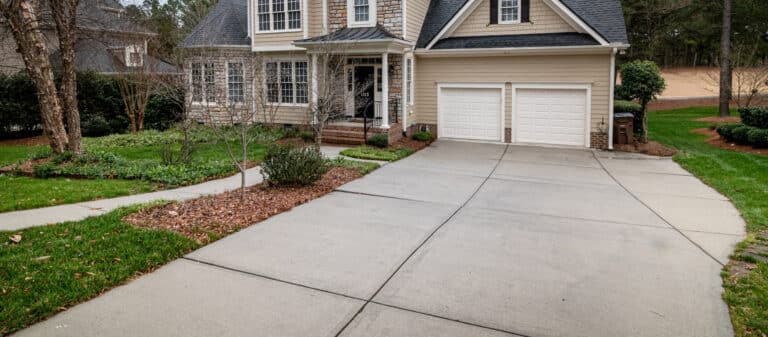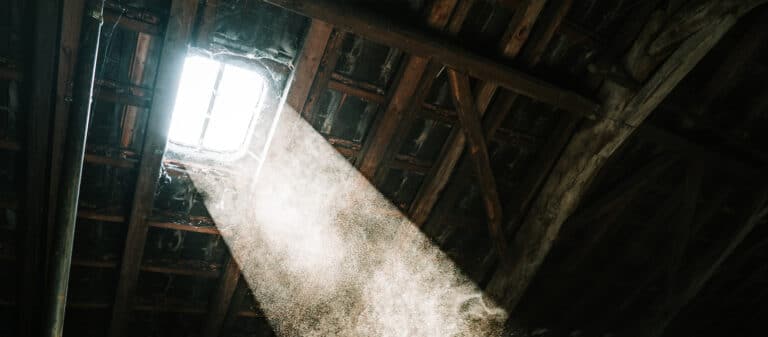Concrete is one of the most ubiquitous building materials on earth and is used for everything from your patio to your foundation and driveway.
With an average lifespan of 50-100 years, concrete will begin to deteriorate and show signs of damage well before it reaches its final stages.
One of the most common issues with concrete slabs, well before total degradation, is that they start to sink into the ground.
In areas like Northeast Pennsylvania that experience rapid freeze-thaw cycles and have infrastructure built on expansive clay soil, sinking concrete is an incredibly common problem.
If left untreated, sinking concrete will form cracks and splits that can become safety hazards.
Fortunately, many proven methods to lift sinking concrete can expand the use of your concrete slab for decades.
This guide will explore the causes and solutions of sinking concrete in our area so that you can make proactive repairs that are affordable and long-lasting.
What Causes Concrete to Sink?
While concrete is one of the sturdiest building materials on earth, the longevity of concrete depends greatly on environmental factors. Some of the most common causes of sinking or damaged concrete in the northeast include:
- Soil Erosion: Water from rain, improper drainage, or plumbing leaks can wash away the soil underneath concrete. Without that foundational support, slabs begin to drop.
- Soil Compaction: If the soil wasn’t properly compacted during initial construction, it may settle unevenly over time, leading to sinking areas.
- Expansive Clay Soils: These soils, common across much of Pennsylvania, expand when wet and shrink when dry. The constant movement causes shifting and voids beneath the concrete.
- Tree Roots: Large trees planted near concrete surfaces can absorb water and dry out surrounding soil, leading to shrinkage and settlement.
Unfortunately, once the underlying support is compromised, the weight of the concrete causes it to settle, crack, and become uneven. From here, you’re faced with a choice: fix it, or start over.
Repairing Sinking Concrete: Methods and Benefits
Repair methods have come a long way in the past two decades, giving homeowners an affordable alternative to completely replacing their concrete. Gone are the days when the only real option was to tear it out and pour new.
Today, homeowners and contractors have access to several innovative techniques for restoring sunken slabs. However, some methods are better than others, as you’ll find out.
1. Polyurethane Foam Injection
A modern alternative to mudjacking, this technique involves injecting lightweight, high-density foam under a slab to support it. The foam expands to fill gaps and gently lifts the concrete.
By most estimates, polyurethane foam can support concrete slabs for decades without risk of further sinking.
- Pros: Lightweight, waterproof, long-lasting, quick cure time (minutes instead of days).
- Cons: Typically more expensive than mudjacking; specialized equipment and experience required.
2. Mudjacking (Slabjacking)
Mudjacking has become a cheap alternative to concrete repair in recent years. This controversial method involves drilling small holes in the slab and pumping in a slurry made of water, soil, and cement. This mixture fills voids beneath the slab and raises it back into place.
The problem with mudjacking is that it only lasts for 3-5 years before the slab will begin to sink once more. To put it bluntly: you get what you pay for.
- Pros: Cost-effective
- Cons: Temporary solution, intrusive, and takes longer to cure.
3. Concrete Resurfacing
Another temporary option to cosmetically fix sunken concrete may be to resurface it and smooth out any cracks or jagged edges. However, this does not address the root cause of the issue and will only result in the same issues down the road.
- Pros: Cost-efficient for minor repairs; improved appearance.
- Cons: Doesn’t address underlying soil issues; mostly cosmetic.
When Is Repair the Better Option?
Generally, most concrete can be repaired with the right methods, especially sinking concrete. You should consider polyfoam lifting or other methods if:
- The damage is localized or minimal. If only one section of your sidewalk or driveway is uneven, a targeted lift can save thousands of dollars.
- The slab is structurally intact. As long as the concrete isn’t severely cracked or crumbling, it can usually be salvaged.
- Budget is a primary concern. Repair options like polyurethane foam injection and mudjacking are significantly cheaper than full replacement.
- Time is of the essence. Many repairs can be done in a few hours, and the area is often ready for use the same day.
- You’re looking to minimize disruption. Repairing is far less invasive than demolition and reconstruction, which involves heavy machinery, noise, and extended downtime.
When Replacement Becomes Necessary
While repair methods are impressive, they aren’t always sufficient. There are times when ripping out the old slab and pouring a new one is the more practical—or even necessary—route.
Some signs that you should replace your concrete instead of repair include:
- Severe Cracking and Crumbling: If the concrete is fragmented into multiple pieces or visibly deteriorated, lifting it won’t solve the core problem.
- Major Structural Issues: If a foundation slab has deep structural damage or the base material is extensively eroded, replacement may be the only viable long-term fix.
- Repeated Settling: If you’ve repaired the same area multiple times with little long-term success, it might indicate deeper issues that require starting over.
- Poor Original Workmanship: Substandard concrete mixtures or poor finishing work during the initial pour can lead to early failure that repair won’t fix.
However, we suggest consulting multiple contractors to assess your options. Replacing concrete is expensive, intrusive, and environmentally unsustainable.
Key Factors to Consider When Fixing Uneven Concrete
So, how do you determine what’s best for your situation? Here are a few questions to guide the decision-making process:
- What’s the extent of the damage? Minor settling usually leans toward repair, while widespread cracking may require replacement.
- How old is the concrete? Newer slabs are better candidates for repair, while older slabs nearing the end of their lifespan might not be worth saving.
- What’s your budget? Repair can often cost less than half of replacement, making it more appealing if you’re on a tight budget.
- Are there underlying issues? Soil stability, drainage, and root systems all play a role. If you don’t address the root cause, even a new slab might settle again.
- What’s your long-term plan? If you’re planning to sell soon, cost-effective repair may be sufficient. If this is your forever home, a more permanent solution could be worth the investment.
Consult a Professional for a Second Opinion
The decision to repair or replace sinking concrete isn’t always cut and dry. A reputable concrete contractor or structural repair specialist can inspect the site, assess the underlying cause of the sinking, and recommend the best course of action.
Many companies offer free evaluations and can provide side-by-side quotes for both repair and replacement.
Be wary of anyone pushing for the most expensive option without a thorough explanation. A trustworthy expert will take the time to explain your options, weigh the pros and cons, and tailor a solution to your needs and budget.
FAQs
When is replacing concrete absolutely necessary?
Replacement is recommended when the concrete is severely cracked, crumbling, or has repeated issues despite previous repairs. It’s also necessary if there’s significant structural damage or if the slab no longer meets functional or aesthetic needs.
Is polyurethane foam better than mudjacking?
In many cases, yes. Polyurethane is lighter, more durable, waterproof, and sets within minutes. It’s ideal for most residential applications, although it’s generally more expensive than mudjacking.
Will repairing concrete fix drainage issues?
Not directly. While leveling the slab can help water flow properly again, underlying drainage problems must be corrected to prevent future settling. This may involve grading, adding drains, or improving downspout routing.






